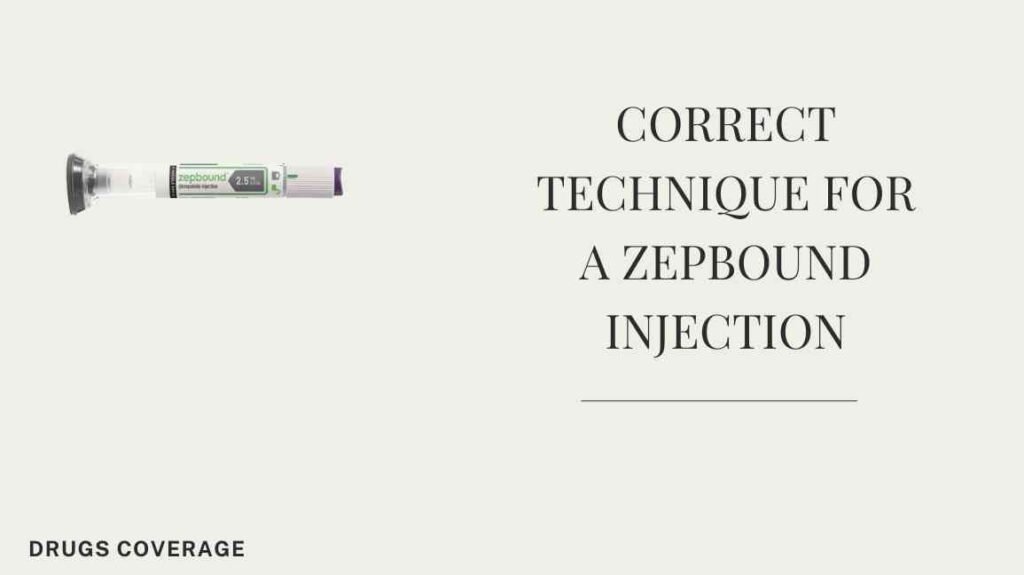
Are you looking for proven ways to control your weight? The new drug Zepbound is changing the game in weight management. It works with your body’s system to control hunger helping people who find it hard to lose weight in usual ways to see big changes.
In today’s article, we’ll show you the best places to inject Zepbound to help you get the most out of this new weight management tool.
We’ll cover everything from understanding the drug to the correct technique for self-administration, and safety considerations to enhance your Zepbound therapy. This guide will help make sure your Zepbound shots work well, safely, and can be kept up.
Understanding Zepbound and Its Mechanism of Action
Zepbound is a big step forward in helping people manage their weight. It was approved in November by the FDA. This new medicine helps adults lose weight in a way that hasn’t been done before, making it stand out from other products like Novo Nordisk’s Wegovy.
Zepbound’s innovative mechanism involves once-weekly injections that mimic the functions of two important gut hormones: glucagon-like peptide-1 (GLP-1) and glucose-dependent insulinotropic polypeptide (GIP).
These hormones are instrumental in regulating a range of physiological responses related to food intake and glucose metabolism.
- What GLP-1 Does: Zepbound works by acting like GLP-1, a hormone, helping you feel full after eating. This means you end up eating less. Feeling fuller sooner and for longer helps stop overeating, making it easier to manage weight.
- GIP’s Role: GIP helps in regulating blood sugar levels post-meal by aiding in insulin release. Zepbound mimics GIP’s function, thereby not only improving blood sugar control but also balancing insulin levels, which facilitates weight loss
By targeting specific hormonal pathways, Zepbound provides a dual-action approach to weight loss, making it a promising solution for those struggling with weight management.
How Does a Zepbound Injection Work?
The Zepbound injection is designed to deliver a consistent dose of the medication into the fatty layer just beneath the skin. This subcutaneous delivery method ensures the slow, continuous absorption of the drug, making its healing effects last all week.
When injected, Zepbound starts working on GLP-1 and GIP receptors in the gut, leading to feelings of fullness, slower digestion, and better blood sugar management.
Over time, each injection helps your weight loss by working together to improve your body’s metabolism, giving you steady and noticeable results.
Zepbound’s once-a-week dose means less hassle in your day-to-day life, keeping your treatment steady without the stress of remembering daily meds.
Related: Does Blue Cross Blue Shield Cover Zepbound?
Where to Inject Zepbound
Figuring out the best spot to inject Zepbound is important for it to work best. For shots under the skin, the stomach, thigh, and upper arm are the best spots because they absorb the medicine well, can hold it, and it hurts less there.
1. Abdomen
The abdomen is often the preferred injection site for many. Choosing a spot away from the navel—approximately 2 inches—can provide a comfortably distanced location.
Rotating the areas you use within the abdomen is essential for consistent absorption and reducing the risk of lipohypertrophy, a thickened, rubbery, or woody hardening of the adipose tissue beneath the skin.
2. Thigh
Selecting a point on the front of the thigh, midway between the knee and hip, and using the outside part of the thigh, can be effective. Make sure that the area is clear of any significant veins and about a hand’s width from the groin to minimize discomfort and risk.
3. Upper Arm
The upper arm, especially the shoulder part, is a good place for Zepbound shots, especially if a doctor or a family member can help give the shot. It’s important to aim for the fatty part above the muscle so the body can absorb it well.
When selecting this site, aim for the middle section of the arm, halfway between the shoulder and the elbow, to ensure the medication is deposited correctly into the subcutaneous tissue.
By regularly rotating the injection site, you can minimize the risk of complications and prevent localized tissue saturation, which could hinder the effectiveness of Zepbound.
Correct Technique for a Zepbound Injection

The correct administration technique is essential for the safe and effective use of Zepbound. Here’s a step-by-step guide to ensure you’re injecting with precision and care:
- Wash your hands: Begin by thoroughly washing your hands with soap and water to ensure cleanliness and reduce the risk of infection.
- Prepare the injection site: Clean the selected area of your skin with an alcohol swab. Let it air dry completely to minimize the risk of irritation.
- Mix the medication if necessary: Some medications require mixing or rolling the vial between your hands. If Zepbound requires this step, follow the instructions precisely to ensure it is ready for injection.
- Remove the cap: Take the cap off the needle. If using a pre-filled pen, follow the instructions for priming the pen if necessary.
- Pinch the skin: Gently pinch the skin around the cleaned area to create a firm surface for injection. This helps ensure the needle enters the subcutaneous layer rather than the muscle.
- Insert the needle: Hold the syringe at a 90-degree angle to the skin, and insert the needle with a quick, controlled motion.
- Inject the medication: Press the plunger down slowly and steadily until all the medication is injected. This slow insertion helps reduce pain and ensures the medication is properly delivered.
- Remove the needle: Once the medication is fully injected, remove the needle at the same angle it was inserted. Apply gentle pressure with a clean cotton ball or gauze to the site, but do not rub.
- Dispose of the syringe: Place the used needle and syringe in a proper sharps disposal container to prevent injury and infection. Do not reuse needles or syringes.
- Rotate injection sites: To minimize tissue damage and enhance absorption, vary the injection site with each dose as recommended earlier in the guide.
Carefully following these steps can make Zepbound work better and reduce any problems or discomfort from the injection.
Safety and Side Effects of Zepbound
Like all medications, Zepbound may cause side effects in some individuals, though not everyone will experience them. The most commonly reported side effects include gastrointestinal issues like:
- Nausea
- Vomiting
- Diarrhea
- Stomach pain
These symptoms are usually mild to moderate in severity and tend to decrease over time as the body adjusts to the medication.
Also, Zepbound can make you less hungry, which helps with weight control. But, if you start losing your appetite a lot or it keeps happening, you should talk to a doctor to make sure you’re still eating right.
Rare but more serious side effects can include:
- Pancreatitis
- Gallbladder problems
- Kidney issues
Symptoms such as severe abdominal pain, jaundice (yellowing of the skin or eyes), or changes in urination should be reported to a healthcare provider immediately, as these could indicate a serious condition.
Hypoglycemia (low blood sugar) may also occur, especially in people who are taking other diabetes medications. Monitoring blood sugar levels as recommended by a doctor is crucial to preventing hypoglycemia.
Lastly, some individuals may experience an allergic reaction to Zepbound, characterized by:
- Rash
- Itching
- Swelling (especially of the face, tongue, or throat)
- Severe dizziness
- Trouble breathing
This requires immediate medical attention.
Before starting Zepbound, people should tell their doctor about their medical past and any other medicines or vitamins they are taking.
Things You Should Avoid When Using Zepbound
When using Zepbound, it is crucial to be mindful of certain activities and substances that could interfere with the medication’s efficacy or increase the risk of side effects. Here are key points to keep in mind:
- Alcohol consumption: Avoid excessive drinking as alcohol can increase the risk of pancreatitis, a known severe side effect of Zepbound. Moderate intake should be discussed with your healthcare provider.
- Other GLP-1 Receptor Agonists: Don’t use Zepbound with other drugs containing GLP-1 receptor agonists, as this could increase the risk of hypoglycemia.
- Other medications: Certain drugs, including over-the-counter medicines, vitamins, and herbal supplements, may interact adversely with Zepbound. Always inform your healthcare provider about any other medications you are taking.
- Driving and operating machinery: Until you know how Zepbound affects you, caution is advised when driving or operating heavy machinery, as some people may experience dizziness or drowsiness.
- High-fat meals: Consuming high-fat foods around the time of taking Zepbound can exacerbate gastrointestinal side effects. Opt for balanced meals to help manage these potential issues.
- Sun exposure: Some individuals may find their skin more sensitive to sunlight while taking Zepbound. Use sunscreen and wear protective clothing when outdoors to avoid sunburn.
If you have any concerns or experience any unusual symptoms while using Zepbound, consult your healthcare provider for advice and support.
What is the Recommended Frequency for Changing Injection Sites?
Rotating injection sites is crucial to prevent tissue damage and ensure effective medication absorption. It is recommended to change the injection site with each dose, avoiding using the same location more than once every four weeks.
This practice helps minimize the risk of lipodystrophy (changes in fat tissue) and localized irritation, ensuring consistent efficacy of the medication. Always keep a record of your injection sites to effectively plan your rotation schedule.
Conclusion
In conclusion, Zepbound is a big step forward in treating some health problems, offering more benefits than old treatments. But, how well it works depends on using it right, knowing the possible side effects, and making recommended lifestyle changes.
By following the guidelines carefully, patients can get the best results, lower risks, and actively manage their health. Always talk to healthcare experts for advice and support when using Zepbound.
FAQ
How to inject Zepbound in the thigh?
To inject Zepbound in the thigh, select a spot on the upper leg, about 4 inches above the knee to 4 inches below the top of the leg. Clean it with an alcohol wipe and let it dry. Sit down comfortably. Lightly pinch your skin to make a fold, poke the needle in straight, and slowly push the medicine in. Release the skin fold and gently press a cotton ball over the injection site after withdrawing the needle. Rotate between thighs for each injection to avoid irritation.
How do I store Zepbound?
Zepbound should be stored in the refrigerator at 2°C to 8°C (36°F to 46°F) until the expiration date. Once in use, it can be kept at room temperature, below 30°C (86°F), for a maximum of 30 days. Do not freeze or expose to direct light. Keep the cap on the pen to protect it from light.
What is the best time to inject Zepbound?
Zepbound’s dosing schedule is flexible, so you can take the injection anytime, morning or night. The most important part is to keep a regular schedule. Picking a set time each week to take it helps the medicine work best and fits it into your day more easily. Staying consistent helps you manage your condition better and lowers the chance of skipping doses.